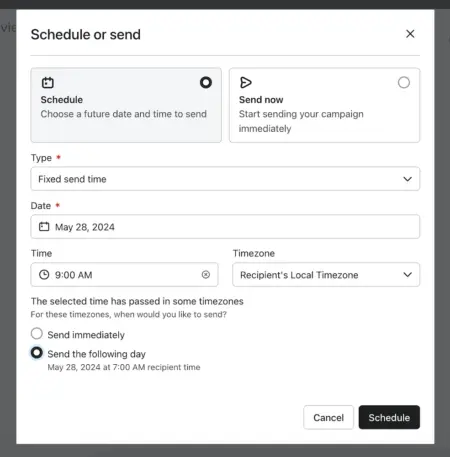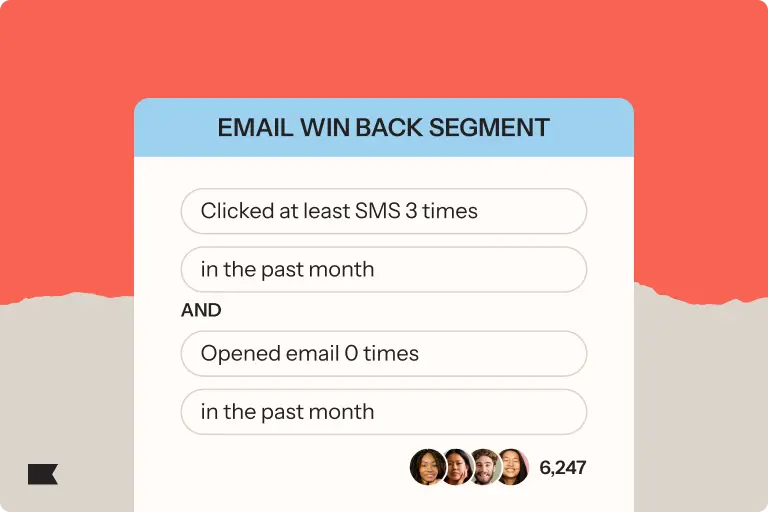Email strategy FAQ: when is the best time to send an email?

If you’ve started to grow your email list and set up a few email campaigns, you’ve got two main decisions to make:
- What time will the email go out?
- And on what day?
These questions seem straightforward enough. But the truth is there’s no simple answer. It depends on a variety of factors, including:
The best time to send out your weekly email newsletter is different from the best time to send out your product launch.
Is the email going to your entire list, your VIP subscribers, customers you’re trying to win back, or any of the demographics in between?
What’s happening there? What season is it? What time zone?
What kind of products or services do you sell? Is it an industry where impulse buys are common, or do your customers typically need more consideration time before purchasing?
How often do you normally send emails or marketing text messages, and what’s the specific goal of this one?
Whether you’re manually optimizing your send times or using data and machine learning to make these decisions, following best practices ensures you get the timing right by sending your emails during time slots when your target audience is most likely to see and engage with them, thereby boosting your email engagement.
Here, we get into some general recommendations for when to send, then dive deeper to teach you how to find the best send times for your specific use cases.
3 reasons why email send time matters (besides open rates)
You may be wondering—if we’re attached to our smartphones all the time, do email send times even still matter?
They do—and not just because they optimize open rates. Email send times also teach you about the habits of your subscribers and customers, acting as a bit of a feedback loop. When you engage in the process of refining your email send times, you’re:
1. Matching subscriber routines
For example, a B2B audience may open more emails in the morning, whereas a B2C audience may open more emails in the evening.
Aligning your email send times with the daily routines of your audience is what ultimately leads to higher open rates, when you can catch people at the right moment in their day for certain types of emails.
2. Reducing email fatigue
As of February 2022, the average remote worker was receiving 171 emails per week. If your emails add to overwhelmed inboxes at inconvenient times, people may begin to ignore them—or, worse, unsubscribe from future emails.
Well-timed emails can help prevent this from happening, because they’re more likely to catch people when they’re at their most open to receiving your email.
3. Enhancing your list segmentation
When you refine your email send times, you gain valuable information. Certain segments of your audience may open your emails over the weekend, while others have lifestyles that make a weekday email more convenient.
As you begin to notice correlations between audience segments, email send times, and open rates, you’ll be able to refine your email send strategy for different parts of your list rather than as a blanket whole.
Find the best time to send marketing emails for you
If your email list consists of less than 12K subscribers, manually segmenting and A/B testing email send times can help you determine when to send your emails based on higher open rates.
Automated emails that are tied to the customer journey, like welcome emails or abandoned cart emails, should be scheduled for delivery based on when your customer interacts with the email trigger.
For promotional emails, start determining your best send time by looking back at what you’ve sent so far to evaluate email engagement and sending behavior. Cross-reference high open rates with send times, note any differences across audience segments, and incorporate performance metrics to make informed decisions. This will be your starting point for experimentation and testing.
Ultimately, your best email send time and day will depend entirely on the factors we outlined at the beginning of this article. Before you send, ask yourself the following questions:
What type of email am I sending?
Your optimal send time will vary depending on what type of marketing email you’re sending. To determine the best time to send different types of emails, here are a few questions to get you started:
Newsletters
- How long will it take to read your newsletter?
- Do you want people to read it all in one sitting, or is it okay if they read it bit by bit, taking breaks in between?
- Is there anything in the newsletter you want or even need people to read at a certain time of day, or on a certain day?
One-time discounts
- Urgency is key for a one-time discount, so ask yourself: how much is enough time for subscribers to get to their inbox, engage with the email, click through to your product pages, and make a purchase? Make sure it’s not so much time that they risk forgetting about the discount entirely.
- Consider including a countdown clock in your email to make the urgency crystal clear to your readers.
Product launches
- How long have your most engaged customers been anticipating a new product? To help foster a feeling of exclusivity, consider sending them an earlier email granting access before less engaged segments.
- How many emails do you plan to send for this product launch in total? How can you build momentum for the product launch? Send out emails before the launch to get your subscribers excited.
- Is your subscriber base engaged enough that they won’t get overwhelmed getting an email every day, even for a short period of time? If the answer is yes, consider timing those pre-product launch emails according to the action you want them to take.
Key factors influencing the best time to send an email
To optimize email engagement, you need to ask yourself some critical questions to better understand your goals, your reader, and the customer experience in general.
What is the action I want this segment to take?
For many marketing emails, the action you’re hoping to inspire is a visit to your brand’s product page and a subsequent purchase.
But if you have other goals—for instance, that people join your loyalty program or read your newsletter—you’ll want to think through some other questions.
Might they read your newsletter during a lunch break, or on their train ride home on a workday? If so, time that send accordingly.
By contrast, if joining your loyalty program requires a few steps or a little research, consider sending those emails when your demographic might have more bandwidth to take on the task.
What time does my audience usually check their email?
Are they highly engaged shoppers whose level of engagement suggests they are likely to mark the email and come back to it? Are they parents who may not get a chance to sit down in front of a screen until after they’ve put their kids to bed? Entrepreneurs who get email alerts on their phones? What about seniors who might not check their email every day?
What you know about your target audience, their lifestyle habits, and device usage (or lack thereof) can help you determine the ideal day and time for your email campaign.
What’s happening where my audience is?
Localization is always relevant to what you sell, who your customers are, where they are in the world, and what’s happening at the time you send.
You don’t want to hit your cupcake enthusiasts at breakfast time, for example. If you want your email to land in your audience’s inbox at 1 p.m., make sure your marketing platform is set for it to arrive at 1 p.m. local time.

But beyond time zones, localization is also important in understanding what’s happening in your subscribers’ part of the world at that time of day.
Things like sunrise and sunset happen at different hours depending on how far north or south you are. Surprisingly, those things matter for lots of brands and shoppers—particularly if you sell, say, blackout curtains or melatonin.
A good marketing platform accounts for user time zones automatically, but remember that what your marketing platform knows about your customers’ time zones is only as good as the data you give it. Make sure your data is up to date and that your organization follows good list hygiene practices.
How frequently am I sending my emails?
Looking at your email marketing program holistically, ask how often you send your subscribers emails and how that affects engagement. That’s a factor you need to take into consideration when deciding which day and what time to send them other emails in the future.
If you’re just starting out, with a small team and less than 20K subscribers, Klaviyo recommends starting with one email campaign per week and eventually working your way up to two email campaigns per week. Stick to a monthly content calender that includes the following campaign types:
- 1 newsletter/snackable campaign
- 1-2 traffic-driving campaigns
- 2 conversion-driving campaigns
To determine the best send time for these email campaigns, take into account:
- Everything you know about your customers
- Everything that’s relevant to your products
- Any context about time of day, season, where your subscribers are, etc.
If you’re sending a certain segment of your audience an email every day or close to that cadence, consider varying the times you send so that you can test open and click rates to inform future strategies.
With Klaviyo, you can turn on Smart Sending, which serves as a buffer between messages so your subscribers won’t receive too many emails from your brand in a certain amount of time.
Find the best email send time for your customers—and your brand
Sending emails at the time subscribers are most likely to open and read them is one of the best ways to enhance email engagement and set your brand up for email marketing success.
Working to grow your email list beyond 12K subscribers? Check out these 5 advanced list growth strategies, and then spend some time with Klaviyo’s Smart Send Time feature and discover how you can make incremental strides towards your larger revenue goals.
Related content
- How to schedule emails to increase open rates: tips and tricks
- Email open rates are (mostly) irrelevant. Here are 7 ways you can—and should—still use open rate data
- Playbook: Create a campaign content calendar in Klaviyo

Related content

Discover the best email marketing platform for ecommerce in 2026. Compare top tools for data, automation, personalization, and deliverability.

Learn how to use Klaviyo SMS, segmentation, and hybrid flows to re-engage lapsed email subscribers, boost deliverability, and drive higher retention.

Boost D2C email revenue from 12% to 30% with the Klaviyo playbook: high-converting pop-ups, a 5-email welcome series, smart filters, and optimized abandonment flows.